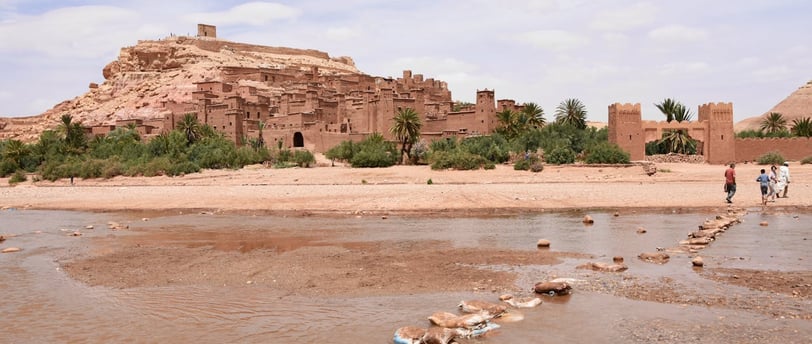Timeless journey into UNESCO World Heritage Sites in Africa
Explore amazing UNESCO World Heritage sites in Africa. From rich history and vibrant cultures to stunning natural wonders, these sites are a must-see!
Mari


The African region, rich in diverse cultures, landscapes, and history, is home to some of the most remarkable and awe-inspiring UNESCO World Heritage sites. From the fossil hominid sites that shed light on humanity’s origins to the vibrant coral reefs and vast natural reserves, cultural and natural wonders offer visitors a chance to dive deep into the past while marveling at the beauty of the present.
In this article, we will explore the UNESCO World Heritage Sites in Africa, their cultural and natural significance, and why they are not just tourist destinations but treasures that deserve global attention and protection.
The Importance of Archaeological Sites:
Each of the world heritage properties represents something special. Whether it’s an archaeological site, a park, or a historic town, they hold Outstanding Universal Value, meaning they offer exceptional significance not just for the country in which they are located, but for all of humanity. They contribute to our understanding of history, culture, and nature, preserving the planet’s rich legacy for future generations.
When a monument is added to the World Heritage list, it receives the protection and conservation necessary to preserve it for the future. This process is essential in keeping these treasures for local communities and future visitors. The World Heritage Committee, led by the UNESCO World Heritage Center, plays a crucial role in overseeing these spots, maintaining their integrity, and promoting their value on a global stage.
A regional overview:
The African continent boasts various UNESCO sites, from ancient civilizations and architectural wonders to natural wonders that capture the imagination. Let’s dive into some of the most iconic and culturally significant landmarks.
1. Robben Island, South Africa:
Robben Island, situated just off the coast of Cape Town, is one of Africa's most renowned UNESCO World Heritage Sites. This small island holds monumental significance as it was once the prison where Nelson Mandela spent much of his life under apartheid rule. The historic center of Robben Island now serves as a powerful symbol of the struggle for freedom and equality in South Africa. It provides visitors with a profound experience, offering guided tours of the prison, including the cell of Mandela and other key places of historical importance.
2. Serengeti National Park, Tanzania:
The Serengeti National Park is one of the most famous national parks in the world. It is known for its dramatic wildlife migrations and its role in the survival of countless animal species. This extensive area of savannah and woodlands is situated in East Africa and is part of the Ngorongoro Conservation Area. A significant destination for understanding modern human behavior and the Pleistocene occupation sites of early humans. The park is home to an abundance of wildlife, including lions, elephants, giraffes, and the famous wildebeest migration, which is one of nature’s most spectacular events.
3. Stone Town, Zanzibar, Tanzania:
The historic town of Stone Town, located on the island of Zanzibar, is another Unesco site that blends history, culture, and architecture. This 16th-century-old town is a captivating mix of Arab, Persian, Indian, and European influences, resulting in an intriguing architectural style. Stone Town is also historically significant for its role in the transatlantic slave trade, where Zanzibar was a key center for the trade of enslaved people. Today, it’s a vibrant city full of local markets, stunning buildings, and cultural landmarks.
4. Ngorongoro Conservation Area, Tanzania:
The Ngorongoro Conservation Area is a historic center This showcases one of the most iconic landscapes in the world. The Great Rift Valley, which runs through the region, creates an extraordinary crater home to a diverse range of wildlife and part of archaeological and fossil hominid sites. It is a living laboratory for scientists studying the natural environment and early human evolution since it holds evidence of modern human behavior and traces of early hominids.
5. Okavango Delta, Botswana
The Okavango Delta in Botswana is one of the world’s largest inland deltas and an extraordinary wetland park. It is known for its exceptional biodiversity. This nature reserve attracts wildlife enthusiasts and nature lovers. The Okavango Delta serves as an essential area for migrating animals, providing them with life-sustaining water and food in one of the driest regions in Africa. The delta is significant not only because of its wildlife but also because it illustrates the interconnectedness of the ecosystem and highlights the importance of protecting the country's diverse natural environments.
6. Victoria Falls, Zambia and Zimbabwe:
Victoria Falls, one of the most famous natural landmarks in the world, straddles the border between Zambia and Zimbabwe. This spectacular waterfall, known as Mosi-oa-Tunya (the smoke that thunders), in Lake Turkana is one of the largest and most powerful waterfalls on the Earth. As a UNESCO World Heritage Site, it holds immense cultural significance for locals and is a crucial part of the Zambezi River ecosystem. Its natural beauty and dramatic scenery draw millions of visitors annually, making it one of the continent’s top tourist destinations.
7. Kasubi Tombs, Uganda:
The Kasubi Tombs, located in Uganda, are a UNESCO-listed cultural site. These rock-hewn churches serve as the burial place of the Buganda kings and symbolize the rich history and traditions of the Buganda people. The tombs are renowned for their architectural style, which uses traditional materials such as grass, wood, and reeds. They stand as a testament to the African people’s deep respect for their royal history and cultural heritage.
Why UNESCO World Heritage Centres Matter in the African Region:
Archaeological sites across the African continent are essential for their cultural and natural significance as well as for preserving the planet's diversity. The African World Heritage Fund is dedicated to supporting the conservation efforts of these historic centers, particularly in countries facing threats from dangerous development, illegal wildlife trade, and climate change. The World Heritage Convention helps to protect these locations by ensuring they are recognized, maintained, and preserved for generations to come.
As tourists and state parties continue to support these efforts, we must also remember the local communities whose livelihoods and cultures are intertwined with these World Heritage properties. Whether it’s through African safari tours, educational programs, or direct involvement in conservation, local communities play a vital role in the protection and sustainability of these places.
Conclusion: Rich Heritage on the World Stage:
UNESCO World Heritage Sites in Africa are more than just tourist attractions—they are the embodiment of humanity’s journey through time. From the fossil hominid sites in South Africa to the rock-hewn churches in Ethiopia, these places carry the legacy of past civilizations while safeguarding the future of our planet’s astonishing natural diversity.
Exploring these destinations allows us to witness the triumphs of human ingenuity, the resilience of nature, and the rich cultural traditions that have shaped the African region over millennia. As we move forward, we must ensure that these invaluable treasures remain protected, celebrated, and appreciated by all.
So whether you’re planning an African safari or seeking to explore the heart of Africa’s history, the Central African Republic offers an unparalleled opportunity to experience the richness and diversity of this extraordinary land. Also, be aware of dangers when traveling.
Explore
Discover
Luxury travel experiences and cultural adventures await you.
© 2024. All rights reserved.
